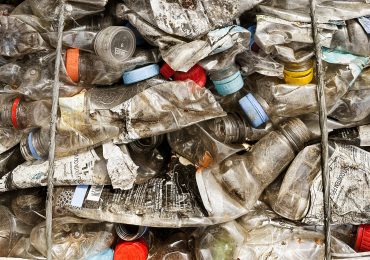Netflix’s newly released documentary, Buy Now! The Shopping Conspiracy, is well timed. It’s a powerful reminder to customers ahead of the Black Friday shopping bonanza that landfills and waste sites around the world are filling up with unwanted clothes, tech, and household goods
[time-brightcove not-tgx=”true”]
According to the Or Foundation, a not-for-profit trying to reduce textile waste featured in the film, more than 15 million unwanted clothes are sent to Ghana—one of the world’s largest importers of used clothes—every week from around the world. Former Apple employee Nirav Patel states that globally, approximately 13 million phones are tossed out daily.
The film argues that companies are keeping consumers in a vicious shopping cycle: alluring advertising encourages people to buy ever more, and products are designed to fall apart quickly, further reinforcing the cycle. Employees of Apple, Amazon, and Adidas acknowledge that brands are focused on consumption, and their jobs were to keep selling more goods.
TIME speaks with the film’s director Nic Stacey and producer Flora Bagenal to better understand the problem, but also the process of bring this documentary to life.
TIME: There have been numerous environmental docs in recent years, some of which do touch on global waste. So, in 2022, when you decided to work on this project, what was your vision and what was the gap that you were seeing in the storytelling that you wanted to fill?
Stacey: The pitch was to create a film about the environment and the consequences of consumerism for people who maybe never actually thought about it before. I didn’t come to this as someone who had a lot of knowledge on the subject but was very interested.
The idea was to try and take the language of advertising—the colorful fantastic world that is used to sell stuff—and turn that back on itself and create something that would have a wider appeal. It’s an incredibly dark subject but we wanted to also find some hope in it, and help people take back the power and break this cycle of consumerism.
The former employees of Apple, Amazon, and Adidas featured in the film did work at those companies, take home significant pay, and then after years, if not decades of work, decide that they wanted to pivot. But they did to some degree benefit from the model. Is there any way around this, particularly in the U.S. where corporate culture is a big part of the economy. How can we get more people working at companies to make change if they’re tied to their employer’s success?
Stacey: It is tough. But Maren Costa, the Amazon user experience designer, is particularly interesting because she did really try and change the system from the inside. [Costa ran activist group Amazon Employees For Climate Justice before being let go.]
We wanted to feature that struggle that people go through all the time when they’re in a company and they’re up against the machine. It’s really tricky. But, I want to inspire people, and remind them that speaking up can lead to change. There will be people who watch it hopefully who may also be more open to their employees raising those kinds of questions in the future, which are small wins. It’s just enabling people to speak up.
The goal of these large companies, particularly publicly traded ones, is to maximize profits at the end of the day. How do we embed sustainability into that model and is it even feasible given the business model they’re operating in?
Stacey: We interviewed Paul Polman, former CEO of Unilever, who did try to make change but ultimately if you are the CEO it is incredibly difficult to sell to the shareholders this idea that you maybe don’t grow as fast, don’t make as much money. That’s where I think people that we elect have responsibility. It’s a negotiation, we need to start thinking about the long-term health of our civilization essentially.
Bagenal: I think that specific question is a really big problem that we face as the whole world and it requires some big thinking and different ways of doing stuff and kind of dismantling systems as well as building new ones.
Were you surprised when you started doing some of the groundwork for this just how massive this problem is?
Stacey: It’s shocking and it’s ridiculous the level of stuff that we produce and more than that it’s the realization that we’re so unaware of the amount of things that we’re producing. We had a section in the film where we tried to illustrate with computer graphics the production numbers. For example, every hour, 2.5 million shoes are produced! We wanted to bring that to life for people to see. Because it’s a huge number and I think people are very aware of their own consumption but you rarely think about what happens when you kind of expand that out to the number of people in the U.S. or in Europe and what the impact of that is.
What has been the response to the film? Have any of the companies featured reached out to you?
Stacey: No we haven’t heard from any of the companies featured yet. We would love to hear from them and are open to conversation. We were unsure about how it would be received and it seems to have just hit such a chord especially among younger people. On TikTok, there’s just so much content that’s been generated around the film. It feels like it’s kind of unlocked or given people permission to talk about this subject in a way that maybe they haven’t had before.
Bagenal: We were nervous about what the companies would say and we intentionally featured a lot of different brands to show people that this is truly a system problem. It’s not just one company. It’s the whole system.
What was the most eye-opening part of this for you personally going through this process? How has this film impacted you both?
Stacey: For me, it was going to Ghana to see the work of the Or Foundation, which has been trying to clean up all the textile waste eating up the country’s coastline. It’s a really jarring sight to see the beach completely covered in discarded clothes. Also, Paul Polman says that we talk about throwing things away or giving things away but away is just another place on Earth and that really resonated with me.
Bagenal: We had a lot of discussions on the shoot about the kind of transient ownership in the world. A company or manufacturer puts something together. They then pass it to you when you pay money for it. And then you pass it onto someone else or a waste collector when you’re ‘done’ with it. But it’s just being exchanged hands.
The other thing that really has changed for me is noticing how much of our culture and public space is given over to selling. We’ve allowed it because it makes money and it is hard to let go of that. Here in the U.K., [local government] councils make money from advertising. Television broadcast companies make money from advertising. Individuals make money for their content.
So how do we fix this? How do we curb all this waste aside from asking consumers to buy less, repair, or buy secondhand?
Stacey: I hope that companies and people in positions of power in large companies will watch the film, take a pause and see that the lifespan of products is a huge issue and that companies need to creatively think about ways that they can extend the lives of the products they make. And we need policy change; governments can help put legislation in place to manage the end of life of a product.
Was there anything you wanted to include the film that you ran out of time and couldn’t include?
Stacey: We spoke to a clothing manufacturer in Hong Kong who told us about a test that they would do on each new garment about 15 years ago: they’d wash the garment 50 times to test how it performs, if it holds up well, and then manufacture the rest of the lot. But now, they don’t do that any more. Speaks to how we don’t think about the lifespan of goods anymore.
Bagenal: Also, we didn’t get into it with this doc but there are countless people who are affected by waste issues near dump sites, and the pollution they’re exposed to. There’s a whole other film in there.
Leave a comment








